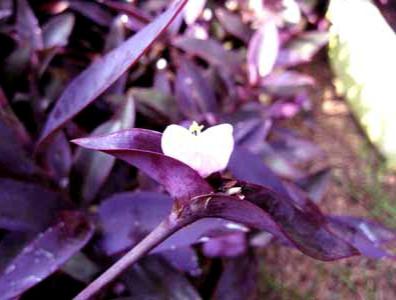By Tommy Clarkson from the March 2019 Edition
Zebra Plant Cryptanthus zonatus
Family Bromeliaceae
Also known as Earth Star, Zebra Star or Guinea Wing
“Now hold on just a moment, Tommy. Earlier, I know for an absolute fact that you told me that the Aphelandra squarrosa a smallish, flowering bush from Brazil was a Zebra Plant. Now you’re telling me that this is as well. Just what’s up Bucko?”
Well, as no few servicemen in Viet Nam heard a few decades ago, in pigeon English/Vietnamese from many a pretty, young “lady” “Me no xơ, G.I.” (Meaning, “I’m not lying, soldier”). Actually, just as many Mike Smiths and Janet Jones share the same name, so do these radically different species of tropical plants. Like the other, earlier-mentioned species, this bromeliad’s principal name is also Zebra Plant.

Ironically, while markedly different in appearance, they share several core aspects, such as their common country heritage of Brazil, once being quite content and comfortable in its rain forest, subject to being good potted specimens and, when in such confined environs, they both reach only about one foot (30.48 cm) in size. But they’re certainly not identical twins.
First of all, according to Kirsten Albrecht Llamas in her wonderful botanical tome, “Tropical Flowering Plants” – Cryptanthus zonatus is now “extinct in the wild.” (This is, I’m sure we’re in agreement, definitely not a good thing.) Domesticated, she says that it likes “regular moisture and humidity, sandy, humus-rich, well-drained soil (and) bright, broken to filtered light.” She continues, saying that their flowers are “white at the base of the leaves (and are) sword-shaped, greenish-gray or reddish brown, boldly marked with jagged bands of silver-white scales, having margins (that are) wavy (with) spines.” [As to this latter part, Cryptanthus zonatus is now extinct in the wild.
should you want to show off a mongst friends, say that its “foliar margin is serrate or toothed!”] She closes saying that“plants in my garden have survived near-freezing temperatures.” Here, in Ola Brisa Gardens, where at a latitude of 19.1138° N, which is virtually the same as Hawaii, we don’t worry about such cool temps they thrive in the rather heavily filtered sunlight, below the fronds of a smallish, slow-growing, Miniature Chusan Palm, along with several attractively complementary, Leopard Aloe plants.
Well, now let’s briefly discuss this subject plant’s family and genus. As to the former Bromeliaceae according to the Encyclopedia Britannica, this is “the pineapple family of the flowering plants with more than 3,000 species across 56 genera.
Each elongated bulb is attached to a stout rhizome and produces 4-9 leaves.
but one species are native to the tropical New World and the West Indies. Spanish moss (Tillandsia usneoides), and the edible fruit of the pineapple (Ananas comosus), are the major economic products of the family, though the fibrous leaves of some species (e.g., Aechmea magdalenae and Neoglaziovia variegata) are made into rope, fabric and netting in some regions.”
It continues with “several species are cultivated indoors as ornamentals for their colourful flowers and foliage, and a number of epiphytic Tillandsia species, known as air plants, are sold as novelties. . . (All) are herbaceous evergreen perennials with simple spirally arranged leaves. Many bromeliads are shortstemmed epiphytes that live in trees or on cacti, though a number are terrestrial. The flowers . . . are often borne in long spikes with distinctive, coloured bracts. Most have fleshy fruit, but some produce dry capsules.”

Yet closer to our subject plant, the Cryptanthus zonatus, author/writer Melanie Dearringer a quite knowledgeable professional on the subject, says, “Cryptanthus bromeliads are unique in that they only grow terrestrially as opposed to many other bromeliads that can grow mounted on a substrate. The genus gets its name from the Greek word meaning hidden flower.
Their flowers are white at the base of the leaves, sword-shaped, greenish-gray or reddish brown, boldly marked with jagged bands of silver white scales having wavy margins with spines.
Cryptanthus are more commonly known as Earth Stars, a name they received because of the shape of their foliage. With over 1,200 different varieties, Cryptanthus have incredibly varied and beautiful foliage, ranging from dark green and variegated to bright reds and pinks to silvery stripes. Most Cryptanthus grow close to the ground and can be as small as three inches in height. However, there are some species of Cryptanthus that can grow as tall as three feet.”
So, what have we learned? Well, I just may be forced to take semantic exception with Gertrude Stein’s purported statement on the law of identity, that “A rose is a rose is a rose.” – her statement of the law of identity!
The full edition or view it online
—
Tommy Clarkson is a bit of a renaissance man. He’s lived and worked in locales as disparate as the 1.2 square mile island of Kwajalein to war-torn Iraq, from aboard he and Patty’s boat berthed out of Sea Bright, NJ to Thailand, Germany, Hawaii and Viet Nam; He’s taught classes and courses on creative writing and mass communications from the elementary grades to graduate level; He’s spoken to a wide array of meetings, conferences and assemblages on topics as varied as Buddhism, strategic marketing and tropical plants; In the latter category he and Patty’s recently book, “The Civilized Jungle” – written for the lay gardener – has been heralded as “the best tropical plant book in the last ten years”; And, according to Trip Advisor, their spectacular tropical creation – Ola Brisa Gardens – is the “Number One Tour destination in Manzanillo”.




